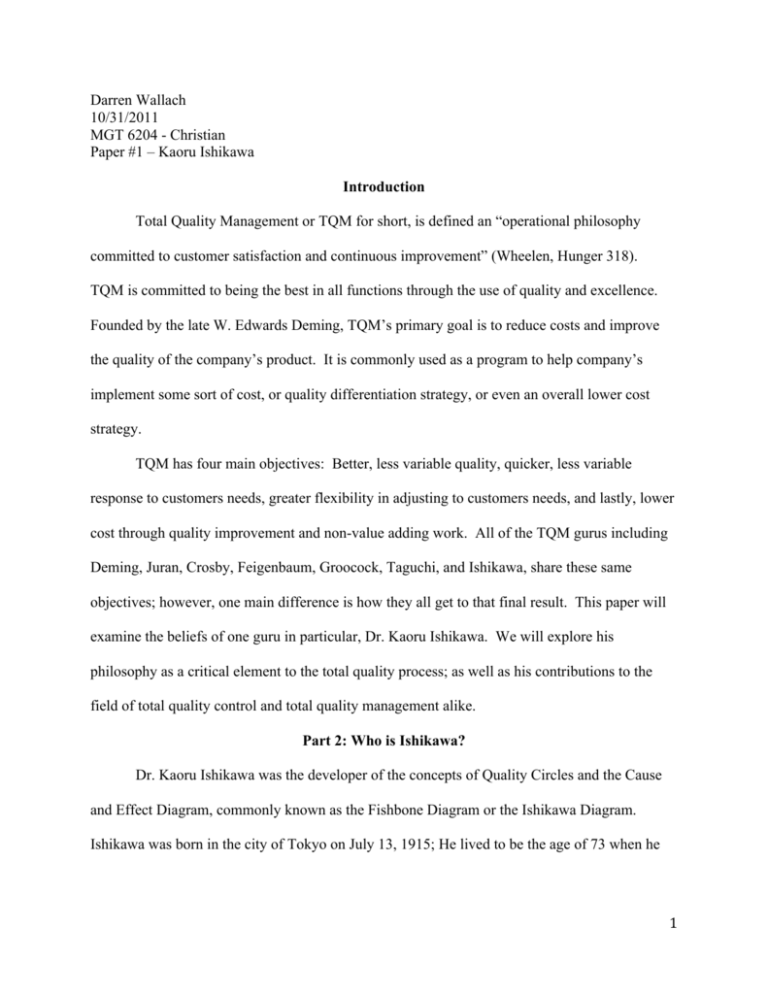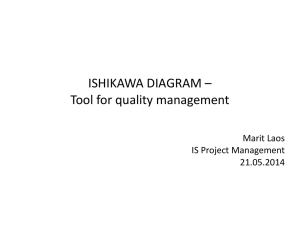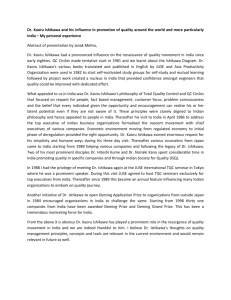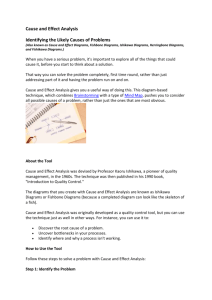TQM Philosophy of Kaoru Ishikawa
advertisement

Darren Wallach 10/31/2011 MGT 6204 - Christian Paper #1 – Kaoru Ishikawa Introduction Total Quality Management or TQM for short, is defined an “operational philosophy committed to customer satisfaction and continuous improvement” (Wheelen, Hunger 318). TQM is committed to being the best in all functions through the use of quality and excellence. Founded by the late W. Edwards Deming, TQM’s primary goal is to reduce costs and improve the quality of the company’s product. It is commonly used as a program to help company’s implement some sort of cost, or quality differentiation strategy, or even an overall lower cost strategy. TQM has four main objectives: Better, less variable quality, quicker, less variable response to customers needs, greater flexibility in adjusting to customers needs, and lastly, lower cost through quality improvement and non-value adding work. All of the TQM gurus including Deming, Juran, Crosby, Feigenbaum, Groocock, Taguchi, and Ishikawa, share these same objectives; however, one main difference is how they all get to that final result. This paper will examine the beliefs of one guru in particular, Dr. Kaoru Ishikawa. We will explore his philosophy as a critical element to the total quality process; as well as his contributions to the field of total quality control and total quality management alike. Part 2: Who is Ishikawa? Dr. Kaoru Ishikawa was the developer of the concepts of Quality Circles and the Cause and Effect Diagram, commonly known as the Fishbone Diagram or the Ishikawa Diagram. Ishikawa was born in the city of Tokyo on July 13, 1915; He lived to be the age of 73 when he 1 passed away on April 16, 1989. He earned his degree in engineering from the University of Tokyo. Once he graduated, he enlisted in the Navy as an acting officer for the Japanese at the beginning of World War II. Fortunately he was lucky enough to get out in 1941, right before the war ended. In 1943, a short time after being out of the military, Ishikawa designed the Cause and Effect diagram (Fishbone Diagram). The initial purpose for designing this diagram was to, “explain to a group of engineers at Kawasaki Steel Works how various manufacturing factors could be sorted and interrelated” (Doggett, 34). After designing the Cause and Effect Diagram Ishikawa started to work for Nissan Liquid Fuel Company; he worked there until 1947. Soon after he started his career as an associate professor at the same University he graduated from eight years prior, the University of Tokyo. In 1949 Dr. Ishikawa joined JUSE, also known as the Japanese Union of Scientists and Engineers, which is a quality control research group. At this time Japan’s industrial industry was still known for making cheap products with very poor quality. Dr. Ishikawas goal was to turn around Japan’s declining production industry; by tailoring the work of Deming and Juran to make their philosophy’s of quality work specifically for the Japanese. Then, in 1962, he developed quality circles, which are groups of people who are trained to identify and solve work problems, they present their final solutions to top management in an effort to improve the performance of an organization. This technique can also be used to motivate employees. Lastly in 1978 he became the president of the Musashi Institute of Technology. Part 3: Ishikawa’s Philosophy Ishikawa’s philosophy focused on transforming the workplace, he wanted people to begin to take pride in the quality of their work. Often times in his book, “What is Total Quality 2 Control?” he mentions the fact that top management cannot be disconnected from the total quality management of the company. He wrote about challenging managers not only to implement the quality into their company, but to keep the mentality of continuous improvement. Besides just continuous improvement of quality, Ishikawa also promoted something slightly different from the other gurus. He valued the idea of a company-wide quality control that was based on a continuous customer service mentality. “He argues that quality control extends beyond the product and encompasses after-sales service, quality of management, quality of individuals and the company itself” (Ghobadian, Speller 53). His dream was for this level of service to seep its way through all levels of management and then make its way into the everyday lives for all those involved. Part 4: Ishikawa’s Contributions Over Ishikawa’s career, he has greatly impacted the world of total quality. In this section, we will discover the several ways he did so. The first contribution includes enhancing Deming’s PDCA model or Plan Do Check Act model, he transformed it into a six step plan; the six steps include: Determine goals and targets, determine methods of reaching goals, engage in education and training, implement work, check the efforts of implementation, and lastly take appropriate action to accomplish goals and targets. Often times this six step process was used by quality circles. Quality circles, which were started by Ishikawa, were extremely popular after they were first tested in the early 1960’s. The main idea of the quality circles was to seek out and solve work-related problems. Arguably the most impressive and widely used quality principle of Ishikawa’s is the Fishbone Diagram. Commonly known as the: Cause and Effect diagram, the Fishbone Diagram, and lastly the Ishikawa diagram. It was developed to “graphically represent the relationship 3 between a problem and its potential causes. Fishbone diagrams can help a group examine thoroughly all possible causes of a quality problem and discern the relationships among them” (Hackman, 1995). Through the construction and use of this diagram, company’s can get a good look at the cause of a problem and then figure out how to reduce or eliminate that problem through the use of improved quality controls. Part 5: The Gurus It is important to recognize the differences between Ishikawa’s philosophy of TQM from all of the other total quality gurus. Guru Definition Emphasis Dominant Factors Deming Customer led Process Control of variation Juran Customer led People Fitness for purpose Crosby Supply led Performance Zero defects Feigenbaum Customer led Process Total quality control Groocock Value led Process Chain of conformance Taguchi Supply led Process/Design Quality loss function value to society Ishikawa Value led People Company wide quality control/quality circles (Ghobadin, Speller, Table 8. Comparing the gurus--summary of approaches) As we can see from the chart above, Ishikawa has a value led philosophy with an emphasis on people and focuses on company-wide quality control and quality circles. Part 6: Fishbone Diagram 4 The Fishbone Diagram can be defined as a problem solving tool, that helps management break down their manufacturing process in order to find the root of the problem. This helps to cut down on defects and ultimately save money and improve quality. To construct a Fishbone Diagram, one must begin by placing the problem on the right hand side toward the head of the fish. Then place the potential causes of the problem on the “bones” that stem off of the spine of the fish. The generic categories are broken up into: materials, machine, measurement, man, and method. The diagram below shows an example of the Fishbone Diagram. The diagram is constructed with the generic causes and other arrows that would normally elaborate on the issue of the initial “bone” on the fish. Ishikawa’s Fishbone Diagram: Machine Material Measurement Effect Man Method Cause Factors Process 5 This is the most notable of all of Ishikawa’s contributions to the field of total quality. This diagram is best constructed when put together by a group that is most knowledgeable about the process of the product from beginning to end. The group would begin to build their diagram much like the example listed above which is constructed with the basic five causes. Furthermore, the group will then brainstorm what variables they believe are contributing to the current problem. The logic behind this is to stimulate the group member’s minds about the core process in order to help them to identify the contributing factors leading to the defect or error. Throughout the process, every member will be forced to think about what they believe is the issue with the production process in relation to each of the five categories. In recent applications, some major airport security teams discovered to be using the Fishbone Diagram not as a problem-solving tool but instead as a planning tool. This was never the intended design of Ishikawa’s model. They use it to plot out how a passenger can board a plane with a weapon. So, as to the way the diagram is set up, they layout the possible ways a passenger can board with a weapon as the “bones” of the fish. They will involve the security experts at that particular airport and think through the potential issue before it happens. Since the terrorist attacks on September 11, 2001, this has been a growing use for the Fishbone Diagram. The application of this method is a great way to analyze how your company controls the quality of its products. Part 7: Conclusion “Ishikawa defines quality as the ‘development, design, production and service of a product that is most economical, most useful, and always satisfactory to the customer’. He 6 argues that quality control extends beyond the product and encompasses after-sales service, quality of management, quality of individuals and the company itself (Ishikawa, 1985)” (Ghobadian, Speller, 53). Ishikawa is one of the six most influential economic personalities in the realm of business quality. He is best known for his Fishbone Diagram theory; this quality tool diagram which identifies the possible causes and effects of a problem. Ishikawa constructed the idea that customers are the only reason why business exists. Now thanks to Ishikawa, Japan is no longer looked at by the world as producing products with poor quality, in fact it’s just the opposite. Today Japan makes some of the best quality products that the market has to offer. All companies can add value to their business by using the principles that Ishikawa created. In the long run they would most likely save the company money and lead them to have a superior product. 7 References Bauer, K. (2005, March). KPI Identification With Fishbone Enlightenment. DM Review, 15(3), 12. Desai, K., Desai, M. S., & Eason, M. K. (2009). Teaching Ishikawa’s “Fishbone” as a Planning Tool. Academy of Educational Leadership Journal, 13(1), 19-35. Doggett, M. A. (2005). Root Cause Analysis: A Framework for Tool Selection. The Quality Management Journal, 12(4), 34-35. Ghobadian, A., & Speller, S. (1994, May). Gurus of quality: A framework for comparison. Total Quality Management, 5(3), 53. Hackman, R. J., & Wageman, R. (1995, June). Total Quality Management: Empirical, Conceptual, and Practical Issues. Administrative Science Quarterly, 40(2), 309. Ishikawa, K. (1985). What is Total Quality Control? (D. J. Lu, Trans.). Englewood Cliffs, N.J.: PrenticeHall, INC. Maze-Emery, E. (2008, November/December). Knowing the Cause is Half the Battle. T & P: Tooling & Production, 74(11/12), 28-29. Wheelen, T. L., & Hunger, J. D. (2010). Strategic Management and Business Policy (Thirteenth ed.). New Jersey: Prentice Hall. 8






